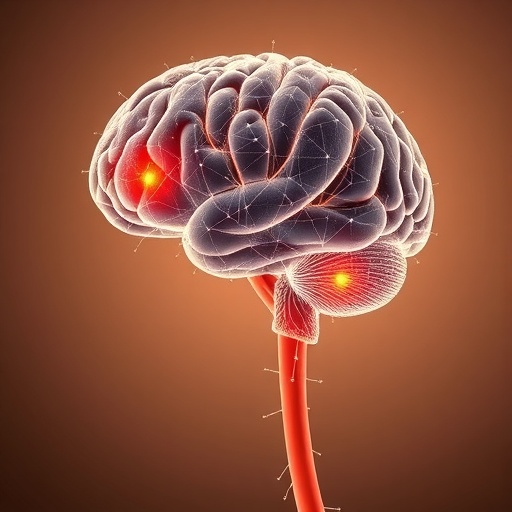In a groundbreaking development that promises to redefine therapeutic approaches for traumatic brain injury (TBI), researchers from the Advanced Chemistry Institute of Catalonia (IQAC) under the Spanish National Research Council (CSIC) have unveiled a potent neuroprotective agent derived from a simple tetrapeptide known as CAQK. Marked by its composition of just four amino acids, this small peptide exhibits a remarkable capacity to localize specifically to damaged brain tissues following acute trauma, opening new avenues for treatment strategies that had long eluded neuroscientific research.
Traumatic brain injury, a significant cause of mortality and long-term disability worldwide, typically results from blunt-force impacts to the skull, often incurred in automotive accidents, falls, or occupational hazards. The absence of pharmacological interventions capable of directly mitigating brain tissue damage or its cascade of secondary inflammatory and apoptotic phenomena has remained a significant clinical void. Traditional management paradigms have largely centered on mechanical stabilization and supportive care to maintain intracranial pressure and cerebral perfusion, leaving a critical unmet need for agents that can intervene at a molecular level to halt or reverse injury progression.
The study, published in the prestigious EMBO Molecular Medicine journal, details how CAQK, when administered intravenously in murine and porcine models shortly after brain injury, homes in on pathological regions with striking specificity. This targeting is mediated by the peptide’s affinity for hyperexpressed glycoproteins within the extracellular matrix of damaged neural tissue—those crucial scaffolding molecules that become dysregulated following traumatic insult. By binding to these altered extracellular matrix components, CAQK accumulates precisely where neuronal architecture is compromised.
Beyond its targeted localization, CAQK’s therapeutic benefits are profound. Experimental investigations demonstrated that treated animals showed a significant reduction in lesion volume, accompanied by decreased neuronal death and attenuated expression of pro-inflammatory cytokines. These findings underscore a dual mechanism of action: direct neuroprotection through inhibition of apoptotic pathways and modulation of the post-injury inflammatory milieu that commonly exacerbates secondary brain damage.
Moreover, behavioral assays assessing cognitive and motor function revealed substantive improvements in treated subjects, signifying not only histological but also functional recovery. Importantly, throughout the course of these experiments, the CAQK peptide exhibited no discernible adverse effects or immunogenicity, underscoring its safety profile as a candidate drug molecule with robust tissue penetration and low toxicity risk.
The origins of CAQK’s discovery trace back to pioneering work employing peptide-phage display technologies, which facilitated the selection of molecular binders with exquisitely high affinity for injured brain tissue. Initial studies utilized CAQK primarily as a delivery vector for pharmacologic agents; however, the current research elevates CAQK from a mere transporter to an active therapeutic substance in its own right. This paradigm shift reflects an enhanced understanding of peptide interactions with the extracellular matrix and post-injury reparative processes.
Particularly notable is the translational relevance of findings derived from porcine models, whose brain physiology closely approximates human neuroanatomy, strengthening the impetus to advance CAQK toward clinical trials. The collaboration between academic institutions and biotech startups, notably Aivocode—founded by key researchers involved in the discovery—epitomizes the synergy between fundamental science and pharmaceutical innovation essential for bridging the gap between bench and bedside.
Looking ahead, the developers of CAQK intend to seek investigational new drug authorization from regulatory authorities such as the U.S. Food and Drug Administration (FDA) to initiate Phase I clinical trials. The peptide’s synthetic simplicity not only facilitates cost-effective manufacturing but also enhances scalability and stability—critical factors for rapid deployment should efficacy be confirmed in human patients.
The implications of this research are vast, offering hope for millions afflicted by TBI each year. The ability to non-invasively administer a therapy that selectively homes in on injured cerebral tissue, diminishes neuroinflammation, and fosters functional recovery could revolutionize emergency and rehabilitative care. Additionally, the non-immunogenic nature of CAQK mitigates potential concerns related to treatment tolerance and adverse immune responses that often complicate peptide-based drugs.
Dr. Pablo Scodeller of IQAC-CSIC, a co-author of the study, emphasized the unmet clinical imperative: “Existing interventions stabilize the patient but cannot arrest the ongoing damage at the molecular level. CAQK offers an elegant solution through selective targeting and mitigation of injury processes.” This sentiment echoes a broader neurological challenge: finding therapeutic modalities that are both effective and non-invasive, circumventing the need for direct intracranial injections that carry risk.
As research progresses, elucidation of CAQK’s precise molecular interactions with glycoproteins and the extracellular matrix will provide insight into tailoring even more efficacious derivatives or combination therapies. The mechanistic novelty of a tetrapeptide exerting potent neuroprotection invites renewed exploration of small peptides in neurological disorders beyond trauma, including stroke and neurodegenerative diseases.
In summary, the discovery of CAQK as a neuroprotective agent signifies a milestone in neurotherapeutics. Its targeted delivery, anti-inflammatory action, and facilitation of functional recovery position it as a pioneering candidate in the long-sought quest to effectively treat acute traumatic brain injury non-invasively. This advancement not only highlights the ingenuity of peptide-based interventions but also the vital importance of interdisciplinary collaborations spanning chemistry, biology, and clinical science to address some of medicine’s most daunting challenges.
Subject of Research: Animals
Article Title: A neuroprotective tetrapeptide for treatment of acute traumatic brain injury
News Publication Date: 1-Oct-2025
Web References: 10.1038/s44321-025-00312-5
Keywords
Clinical medicine, Diseases and disorders, Traumatic brain injury, Neuroprotection, Peptides, Neuroinflammation, Extracellular matrix, Neuroscience, Drug development, Translational medicine




